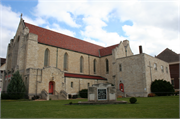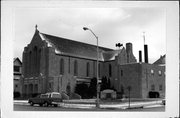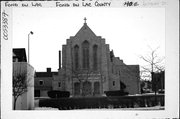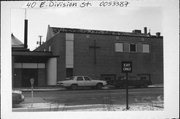Property Record
40 E DIVISION ST
Architecture and History Inventory
| Historic Name: | Immanuel Trinity Evangelical Lutheran Church |
|---|---|
| Other Name: | Immanuel Trinity Church |
| Contributing: | |
| Reference Number: | 53387 |
| Location (Address): | 40 E DIVISION ST |
|---|---|
| County: | Fond du Lac |
| City: | Fond du Lac |
| Township/Village: | |
| Unincorporated Community: | |
| Town: | |
| Range: | |
| Direction: | |
| Section: | |
| Quarter Section: | |
| Quarter/Quarter Section: |
| Year Built: | 1930 |
|---|---|
| Additions: | |
| Survey Date: | 2010 |
| Historic Use: | church |
| Architectural Style: | Early Gothic Revival |
| Structural System: | |
| Wall Material: | Limestone |
| Architect: | Clarence Jahn |
| Other Buildings On Site: | |
| Demolished?: | No |
| Demolished Date: |
| National/State Register Listing Name: | Not listed |
|---|---|
| National Register Listing Date: | |
| State Register Listing Date: |
| Additional Information: | 1988: This large church building is constructed of limestone and has a steeply-pitched gable roof with parapets. There are numerous Gothic-arched openings punctuating the walls and on the front wall these openings are very large and filled with decorative stained glass. They are filled with stained glass on the side walls as well. The main entrance consists of three Gothic-arched entry doors accented with a stone frontispiece. A two-story addition projects from one corner of the building. This church building is architecturally significant as a fine example of a late Gothic Revival church. While the building has a massive quality in its form and massing, earlier Gothic details like towers with battlements and buttresses are not seen on this building. It is more streamlined, reflecting the era in which it was constructed. It is, though, one of the outstanding churches in a city with many outstanding church buildings. This church was organized in 1911, primarily to provide English speaking Lutherans their own congregation, St. Peter's being a predominantly German church. A church building was constructed in 1913 (not extant). Trinity English Lutheran Church merged with Immanuel German Lutheran Church in 1920, creating the congregation that would complete this church in 1930. 2010-2011 Intensive Survey Info: Sheathed with limestone, this Neo-Gothic Revival-style church (#53387) has a gabled roof covered with red slate shingles. The primary (north) elevation features a series of three segmentally arched, recessed openings; the central wooden doors are paired, while the outer examples are single. Modernized buttressing accents either corner, while a series of three tall-and-narrow, Gothic-arched windows occupy the space above the entrance and are separated from it by a row of ornamental stone quatrefoils. Quatrefoil tracery is also evident in the windows. One-story, side aisles accented with buttressing extend from both the east and west elevations, above which are four, symmetrically arranged, Gothic-arched windows. A one-story, secondary entry to the church, with a round-arched doorway is located on the west side, near the front/north, while nearly full-height wings with parapet endwalls extend from near the building's south end, creating an overall cruciform plan. A two-story, stone sheathed office wing extends from the south end of the west side of the church; its stone sheathing matches that of the church. A rectangular, two-story, Contemporary-style, parish hall (Built 1952; AHI#207881) extends from the rear of the church and fronts S. Marr Street. Immanuel Trinity Evangelical Lutheran Church was formed in 1920, following a merger of the Immanuel German Lutheran and Trinity Lutheran churches of the city. The combined membership in 1920 was identified as 675 persons. Talks regarding the construction of a new church began in 1922; however, the subject church was not completed until 1930. Costs were estimated at $100,000; however, the final cost is recorded as $116,000. The architect of the religious facility was Fond du Lac native, Clarence Jahn, while Immel Construction Co. served as the builder/contractor. Jahn received his architectural training at the University of Pennsylvania, from which he graduated in 1929. Jahn later moved to Milwaukee to join Herman W. Buemming, to form the firm of Buemming & Jahn. Jahn died in 1943, at the age of thirty-eight. Efforts were made to utilize local materials, as well as local labor. Indeed, less the Indiana limestone trim, the majority of the exterior limestone was quarried just a few miles south of the city. On the interior, most of the elaborate wood carving was done by artisans at the Rosenthal Woodworking Company, Fond du Lac; however, of note, the carving of The Last Supper was done by a Milwaukee shop. It was estimated that more than 90 percent of the work on the building was completed by Fond du Lac men. The parish utilized their former church as a parish hall until a new one was built along S. Marr Street in 1954; the same year of the wing to the east. In 2002, discussions of whether to remodel the church or build anew resulted in a 45% to 55% vote, the latter in favor of building at a new site. The downtown location served the Immanuel-Trinity congregation until 12 June 2011, when the last mass was held there. They have since resumed mass at their new church building located at 20 Wisconsin American Drive. The church is a very good and intact example of the Neo-Gothic Revival style and compares favorably to others in the city. Admittedly the wings to the east and west were added at a later date, however, the west wing is sheathed in the same limestone as the church proper and the east Contemporary wing would be considered as a non-contributing addition if a historic boundary were to be drawn around the building. 2016- "The church was organized in 1911 to provide English speaking Lutherans with their own congregation because St. Peter's Lutheran was predominantly a German church. In 1920, Trinity English Lutheran Church merged with Immanuel German Lutheran Church, leading to the construction of this Neo-Gothic Revival church in 1930. The congregation made efforts to utilize local materials, including limestone from a quarry outside the City; local artisans created the interior wood carving. More than 90% of the building was completed by local labor. In 2002 the congregation voted in favor of building a new church at a different site. In recent years a local developer, Commonwealth Development, purchased the property and opened Trinity Restaurant and Banquet Hall, while maintaining the exterior and interior architectural details." -"City of Fond du Lac - Memorandum", January 20, 2016, from Dyann Benson (Community Development Director). |
|---|---|
| Bibliographic References: | (A) Fond du Lac City Directories. (B) Sanborn-Perris Maps - Fond du Lac. (C) Fond du Lac Tax Rolls. (D) Carol Cartwright, City of Fond du Lac Intensive Survey Report, Fond du Lac: City of Fond du Lac, 1992. Building permit for church, 30 July 1929 "Architect Uses Gothic Lines of Past Centuries," Fond du Lac Commonwealth Reporter, 15 March 1930. Please see 2010-2011 Intensive Survey for additional citations for information below. |
| Wisconsin Architecture and History Inventory, State Historic Preservation Office, Wisconsin Historical Society, Madison, Wisconsin |





